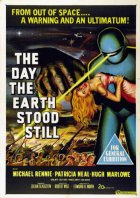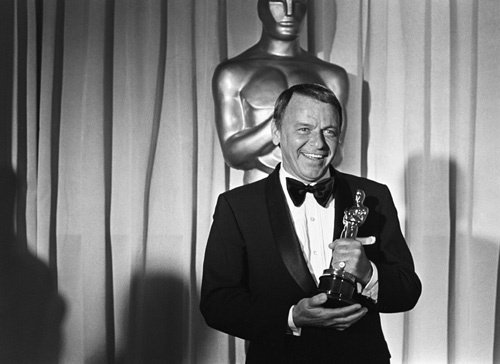
The Day the Earth Stood Still Page #3
- G
- Year:
- 1951
- 92 min
- 2,155 Views
ANOTHER ANGLE:
PEARSON:
The ship, designed for travel outside
the earth's atmosphere, landed in
Washington today at 3:47 p.m., Eastern
Standard Time. We still don't know
where it came from, but I can reveal
that military leaders are considering
two possibilities; that it came from
some unfriendly power here on earth --
or that it actually arrived from
another planet.
CAMERA PANS to and DOLLIES IN on the TV screen in the wall.
On the screen is a shot of the space ship.
PEARSON'S VOICE
(over scene)
The ship is resting exactly where it
landed two hours ago, and there has
been no sign of life from inside it.
OUR CAMERAL HOLDS on the TV screen. The cuts that follow are
inside the frame of the screen:
EXT. THE MALL - MED. SHOT
Two platoons of infantry soldiers surround the ship, their
rifles at the ready.
PEARSON'S VOICE
(over scene)
Troops have been rushed from Fort
Myer and they have formed a cordon
around the ship.
MED. SHOT
showing two machine guns, two Sherman tanks and two 75MM
guns. The gun crews are posted for action and all weapons
are trained on the space ship.
PEARSON'S VOICE
(over scene)
They are supported by machine guns,
tanks and artillery.
Cops are holding back a section of a large crowd, some
distance away from the ship. The people are wide-eyed and
tense with excitement.
PEARSON'S VOICE
(over scene)
Behind police lines, there is a large
crowd of curiosity seekers.
SERIES OF INDIVIDUAL CUTS
1. Civilians in the crowd, their eyes and nerves taut with
suspense.
2. A young soldier, who grips his rifle and moistens his
lips nervously, his eyes never leaving the ship.
3. A tank commander blinks from the tension of staring at an
unmoving object.
4. The last cut is of the ship itself.
PEARSON'S VOICE
(over scene)
As you can see for yourself, the
Army has taken every precaution to
meet whatever the situation may
require. Every eye -- every weapon --
is trained on the ship. It's been
this way for two hours and the tension--
CLOSE SHOT - PEARSON
as he interrupts himself excitedly, his attention riveted on
the TV screen.
PEARSON:
Just a minute, ladies and gentlemen!
I think I see something moving!
EXT. THE MALL - MED. LONG SHOT - DAY
We are at the actual location now, not looking at TV. We see
the ship surrounded by soldiers, two medium tanks, two
artillery pieces, and a couple of machine guns. Some distance
away is a suggestion of the crowd of civilians, held back by
police. Prominent in the scene are newsreel and television
cameras. OUR CAMERA MOVES IN to MED. SHOT. As it does so, we
see a couple of metal objects rising slowly from the top of
the ship. One, which is an oddly-designed coil of wire, slides
up and revolves slowly. The other is a section of vented
pipe with a convex cap on it.
REVERSE ANGLE:
on the soldiers, their eyes glued to this first sign of
activity from the ship. They shift uneasily, gripping their
rifles more firmly.
After a long, tense moment, a ramp appears silently out of
the side of the ship and slides down to the ground. There is
an audible gasp as a man appears at the top of the ramp. He
looks around at the crowd with cool and imperturbable dignity.
This is KLAATU. He is completely human in appearance. The
only unearthly thing about him is his clothing. He wears a
tunic that is very good looking, but at the same time
thoroughly comfortable and practical. On his head is a metal
helmet that obscures most of his face. (It would be impossible
to identify him later.) The design of this helmet gives the
impression that it is more a formal headdress than for
protection. Klaatu is above all an impressive man -- a man
of tremendous dignity and presence. He has the tolerant
superiority that comes with absolute knowledge.
INDIVIDUAL REACTION CUTS
of soldiers, people in the crowd, and policemen. The newsreel
and TV men are busy at their cameras.
After an impressive moment, he raises his arms in the
universal gesture of neutrality. Then he speaks, in perfect
English, his voice amplified as though through an enunciator.
KLAATU:
We have come to visit you in peace --
and with good will.
Klaatu walks slowly down the ramp toward the soldiers. As he
does so, he draws from inside his tunic a strange looking
object, longish and tubular. It might be a a telescope -- or
it might be some strange kind of weapon.
MED. SHOT
shooting from the side, showing Klaatu advancing slowly toward
the line of soldiers. He holds out the mysterious object in
front of him in a gesture that is actually one of offering
but could be misinterpreted as menacing. There is a growing,
uneasy rumble of muttering among the soldiers as Klaatu
advances. They are clearly frightened of what he may do.
Translation
Translate and read this script in other languages:
Select another language:
- - Select -
- 简体中文 (Chinese - Simplified)
- 繁體中文 (Chinese - Traditional)
- Español (Spanish)
- Esperanto (Esperanto)
- 日本語 (Japanese)
- Português (Portuguese)
- Deutsch (German)
- العربية (Arabic)
- Français (French)
- Русский (Russian)
- ಕನ್ನಡ (Kannada)
- 한국어 (Korean)
- עברית (Hebrew)
- Gaeilge (Irish)
- Українська (Ukrainian)
- اردو (Urdu)
- Magyar (Hungarian)
- मानक हिन्दी (Hindi)
- Indonesia (Indonesian)
- Italiano (Italian)
- தமிழ் (Tamil)
- Türkçe (Turkish)
- తెలుగు (Telugu)
- ภาษาไทย (Thai)
- Tiếng Việt (Vietnamese)
- Čeština (Czech)
- Polski (Polish)
- Bahasa Indonesia (Indonesian)
- Românește (Romanian)
- Nederlands (Dutch)
- Ελληνικά (Greek)
- Latinum (Latin)
- Svenska (Swedish)
- Dansk (Danish)
- Suomi (Finnish)
- فارسی (Persian)
- ייִדיש (Yiddish)
- հայերեն (Armenian)
- Norsk (Norwegian)
- English (English)
Citation
Use the citation below to add this screenplay to your bibliography:
Style:MLAChicagoAPA
"The Day the Earth Stood Still" Scripts.com. STANDS4 LLC, 2025. Web. 21 Jan. 2025. <https://www.scripts.com/script/the_day_the_earth_stood_still_1006>.






Discuss this script with the community:
Report Comment
We're doing our best to make sure our content is useful, accurate and safe.
If by any chance you spot an inappropriate comment while navigating through our website please use this form to let us know, and we'll take care of it shortly.
Attachment
You need to be logged in to favorite.
Log In